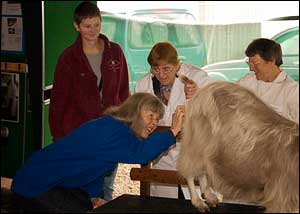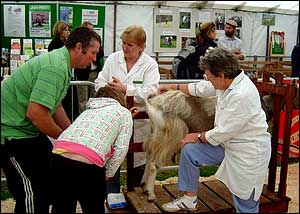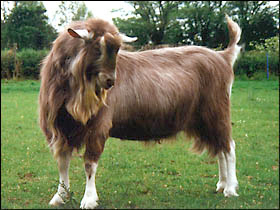What is the age at which goats can breed?
Female kids will come into season in their first autumn (September to December), and could be mated at this time i.e. at about 6 months old provided they are well grown and mature but the aftercare of these “kidded kids” needs to be especially good if the goat’s full potential is to be realised. In the UK, most pedigree breeders do not mate their female goats until they are about 18 months of age.
Male kids may become sexually active when only a few weeks old! This means that male kids need to be kept separate from females from about six weeks of age or there could be “accidents”. Male kids are used for stud purposes in their first autumn, although late born kids may not be ready until later in the breeding season.
How can you tell when a goat is ready for mating?
The sure signs of oestrus are wagging of the tail with a rapid side-to-side movement and wetness around the vulva and the feathers of the tail. Other signs are redness and swelling around the vulva, noisy bleating and a change in behaviour. Not all of these signs may be present, and the wagging may only become present when the female smells the male. If you run your hand along the female’s back towards the tail end, wagging may be stimulated too. If you have a male on the premises, you can use him as a teaser i.e. close, but not too close. Alternatively a “Billy rag”, which is a piece of cloth smelling of male goat (normally kept in a sealed container!), can be waved in front of the female. Once a goat starts coming in to season, if unmated it will generally return every 21 days. The length of season is generally two or three days but can last from a few hours to four days or more. Shorter seasons are more common at the beginning and end of the breeding season.
Contact your Veterinary Surgeon about any goat you wish to breed from which has not come into season by the end of November. This allows time for treatment before the end of the breeding season.
What are the options in getting a goat mated?
It is of course very easy if you keep your own male. The next alternative in order of popularity is to travel to use a male that has been advertised as being at stud. These advertisements appear in the publications of various Breed Societies, BGS Affiliated Societies and the BGS Monthly Journal and Year Book. An initial enquiry via your nearest BGS Affiliated Society, will point you in the right direction. When you think the goat is in season or is coming in to season you should telephone the owner or agent of the stud goat you want to use and arrange a mutually convenient time to transport your female to the male. Mating generally takes place within a few minutes and you can then take your goat home.
The owner of the pedigree male should issue you with a Certificate of Service, which will enable registration of the offspring. Some stud goat owners offer transport and/or boarding, but these require additional payments. Nearly all stud goat owners will only accept goats for service that have been C.A.E. negative tested, so you should take the test certificate with you as proof.
Artificial insemination (AI) is an increasingly important breeding tool, especially if you wish to incorporate rare or superior bloodlines.
The best person to AI a goat is the owner or a familiar person as stress will then be kept to a minimum and the optimum timing as accurate as possible for a successful outcome.
BGS Approved Goat AI Courses are held around the UK (& overseas) wherever a few trainees can get together.
More details on:- http://www.goatgenetics.com/ai.html
 Demonstration at the BGS Commercial Goat Exhibition. (2008 RABDF Dairy Event)
Demonstration at the BGS Commercial Goat Exhibition. (2008 RABDF Dairy Event)
 Demonstration at the Royal Show in 2009. (The last Royal Show)
Demonstration at the Royal Show in 2009. (The last Royal Show)
Two demonstrations illustrated above enabled those interested to see inside the goat. The equipment used was a *Slim-Line* light source and *Slim-Line* speculum imported from the USA (available for inseminators in UK).
The AI procedures were also being explained.
What is the right male for my goat?
Male goats should be of correct breed type with sound conformation. Male goat shows are often a good place to observe potential sires, whilst a visit to see the male in his home environment, alongside relatives and daughters is highly recommended.
How important is pedigree? In dairy goats, more so than with any other type of livestock, studying the pedigree of your goat and its potential mate gives valuable information about the performance of their ancestors, as milking awards and milk yields form part of each animal’s permanent record. Breeders often use a pedigree a minimum of five generations, because very close breeding, in the fifth and later generations, has a very strong influence on the pedigree of potential offspring.
The conformation and performance of ancestors and offspring are important with any breed of goat. For dairy goats, milk quantity and quality can be assessed by looking at show records, milking competition data, and milk-recording figures. These figures can be researched in the various BGS publications: the Herd Books, the Monthly Journals and the Year Books where there are many photographs. The performance records of the male’s dam and his sire’s dam are of prime importance and should be of the highest standard.
For non-dairy goats other criteria such as fibre quality and live weight gain will be important. More detailed information is available from the various Breed Societies.
What should I do in the time leading up to my goat being mated?
For the two months prior to breeding you should ensure that the female is fit but not fat. A goat that tends to be fat should have been on a reducing diet, but for the week or two prior to mating should be put on a gradually rising plane of nutrition.
The goat should have been wormed and its feet trimmed: the ear marks should be checked to confirm that, if necessary, they can be read easily; a booster vaccination 4 in 1 injection such as “Lambivac” should have also been given.
The CAE certificate for the goat should be checked to confirm that it is still within 12 months of the test.
The stud goat owner should have been contacted and provisional arrangements made.
You should study all the books and videos you can about goat breeding and kidding.
What is the gestation period for goats?
Approximately 150 days, but up to one week either way is fairly common. Better to be prepared well in advance.
What preparations should I make prior to my goat kidding?
Make sure you have studied all of the relevant parts of books and videos on this topic, many of which contain clear diagrams of the expected event. Don’t get worried, in most cases, goats manage perfectly well on their own and any help that is needed is minimal.
It is worthwhile to collect together a set of items which might be needed during the actual kidding, or immediately afterwards. Many of them could be put in one box, to be ready at a moments notice.
The recommended list includes:
- A bucket for warm water
- A bar of soap and nailbrush
- Some veterinary obstetric lubricant gel
- Some clean cotton towels
- Roll of paper kitchen towels
- A pair of sharp surgical scissors
- An antibiotic spray obtained from your vet
- A stomach tube and syringe for colostrum feeding
- Kid feeding bottle, teat and a half litre plastic jug
The goat’s pen should be well cleaned and disinfected at least a week before kidding. A low hurdle should be available to section off a corner in the kidding pen, should it be thought to be advisable to protect the kids from being trampled on etc. The dam should be able to see, smell and lick her kids, even if they are placed behind the temporary partition.
On hand should be the telephone numbers of at least one vet, and at least one experienced goatkeeper or shepherd and a mobile phone if no permanent phone is nearby.
As soon as the first signs of birth are observed, remove the water receptacle from the kidding pen until after parturition is complete.
How do I know when kidding is about to take place?
Several changes in the body shape and udder usually take place as the time of kidding approaches, although the degree and order may vary for goat to goat.
These are the most common changes:
- The udder will start to grow and eventually fill with milk (don’t milk her before kidding unless it becomes very tight indeed, but if it becomes necessary only take enough to ease the udder).
- The goat’s shape may alter, the weight shifting downwards and leaving her slightly hollow flanked.
- The part of the backbone near the tail appears to have risen, becoming slack either side (called “ridging up”).
- The vulva becomes increasingly puffy; eventually there will be a colourless discharge from it.
- She may start “talking” to her unborn kids or making unusual noises.
- She will become increasingly restless, pawing at her bed and making hollows, repeatedly lying down and then getting up again.
What happens in a normal kidding?
The actual labour begins with severe and frequent straining on the part of the goat, which should result in the expulsion of the kid within its covering of membranes, after about 15 minutes. The membrane bag is usually seen first, with two hooves (one slightly behind the other) and behind them a nose, all inside the membrane bag. Many kids are also produced hind feet first quite normally. Sometimes the membrane will have burst internally anyway, and this is also quite normal. Immediately after the birth of each kid make sure the mouth and nostrils are clear of fluid and not clogged by anything; kitchen paper towels are useful for this.
There may be a 15 to 20 minutes interval between the births of twins or triplets and during this time some goats do tend to wander round and round their stalls to the detriment of their already staggering offspring. The kids of such dams should be collected up and placed behind a partition in the corner of the pen so that the goat can see the kids and reach over to lick them without walking or laying on them.
Finally, there is the expulsion of the afterbirth (placenta). This may occur anything up to an hour after a normal birth. Do not pull on the placenta; this could be fatal to the goat. It is advisable to make quite certain that afterbirth expulsion is complete. If the afterbirth is not collected and removed then the dam may eat it. They can be eaten very quickly, and an apparently “missing” placenta can catch out even experienced goatkeepers.
If however, the afterbirth has not been expelled i.e. it is still hanging there, after 10 hours, contact your vet.
Fortunately most kiddings are normal, as described. Slight malpresentations of kids can delay birth, but can easily be dealt with if experienced help is sought (hence the mobile phone in the “kidding” kit!). You may even miss the kidding completely.
When do I need to call for experienced help?
(Even in the middle of the night)
- If the goat has any unusual coloured discharge from the vulva.
- If the birth fluids (waters) come away but straining does not start.
- If hard labour (lying down and pushing) has been taking place for half an hour without result.
- If the goat is kidding a head appears, but no feet; a tail appears first; two front feet appear and the head does not follow.
- If the udder is hot and swollen, the milk is clotted or stringy.
- If the newly kidded goat is running a high temperature of 40degC (104degF) or more and is depressed, not eating or reluctant to get up.
What should I do to care for the kids after their birth?
Some details will depend on whether the kids are to be reared on the dam.
If the kids are still wet after being licked by their dam it is best to rub them dry with a towel. The remains of the umbilical cord and the navel need to be sprayed with an antibiotic spray or dipped in veterinary iodine solution (7%). Overlong cords can be trimmed as necessary.
 All kids should receive colostrum (first milk) within two hours of birth. Make sure any seal is removed from the dam’s teats before coaxing the kids to take colostrum. The mother will often play a part in the persuasion process too. It is a most natural situation, after all! Kids can usually be persuaded to take milk from their dam, or can be fed at least 140mls of their dam’s colostrum via a bottle. For a weak kid, or one who will not suck it is quite easy to use a stomach tube, which allows colostrum to be passed directly to the stomach until the kid, can be persuaded to take a bottle. Weak kids or kids with over enthusiastic dams may need to be placed behind a partition in the corner of the pen. Hence be prepared!
All kids should receive colostrum (first milk) within two hours of birth. Make sure any seal is removed from the dam’s teats before coaxing the kids to take colostrum. The mother will often play a part in the persuasion process too. It is a most natural situation, after all! Kids can usually be persuaded to take milk from their dam, or can be fed at least 140mls of their dam’s colostrum via a bottle. For a weak kid, or one who will not suck it is quite easy to use a stomach tube, which allows colostrum to be passed directly to the stomach until the kid, can be persuaded to take a bottle. Weak kids or kids with over enthusiastic dams may need to be placed behind a partition in the corner of the pen. Hence be prepared!
What should I do to care for the dam after kidding?
If it has been an assisted birth the mother should receive an antibiotic injection, but your vet must be consulted about this. The new mother usually appreciates a bucket of warm water straight after kidding.
Most goatkeepers will leave the kids with their dam for at least 4 days. For most goats the period after kidding is a time when careful observation is required as the animal settles down into her new routine.
Give plenty of good quality hay and other forage and make sure clean water is available at all times. Gradually increase amounts of concentrates to sustain the increasing milk production.
If the goat is producing more milk than is necessary for the kids the udder can be eased as necessary. If the goat does not have her kids with her then the udder should be milked out sufficiently to avoid the likelihood of mastitis from an overstocked udder. Many breeders prefer a gentle start to the lactation, however, because there is also a possibility of milk fever if large yields are produced soon after kidding.
If the goat suddenly will not eat any concentrates you should contact your vet, the goat may have acetonaemia and the sooner this complaint is treated the better.
It is a good idea to worm your milker within the first 4 days of kidding, since it is advisable not to drink the milk during this period.
It is normal for all freshly kidded goats to have a blood stained discharge that lasts for up to 3 weeks. During this period tail hair may need washing or trimming. A foul-smelling discharge in a sick goat may indicate metritis, which will need veterinary attention.
Where can I obtain further information?
Consult the list of BGS Affiliated Societies or the Breed Society or club to which you belong. Each of these will have specialised information, which will be helpful to you. Having made an initial contact obtain any specialised leaflets they have. For example the Pygmy Goat Club has chapters in its literature devoted to breeding kidding; it also has area contacts that can advise you. Also you might like to look at the web site of the National Pygmy Goat Association (of America) for specialist line articles.
BGS Affiliated Societies have secretaries who may give you details of their members who may be able to help you. Alternatively they may be able to help you directly.
If there is no Affiliated Society near you contact the Secretary of the BGS, who may be able to help you.
Some websites have images at various stages of kidding, and these might help you to recognise what is normal.
Viewing the video “Goat Breeding & Kid Rearing” might be helpful since it contains sequences of natural and assisted kiddings and also discusses pre kidding and post kidding care. Some Affiliated Societies have copies, which they may loan out

